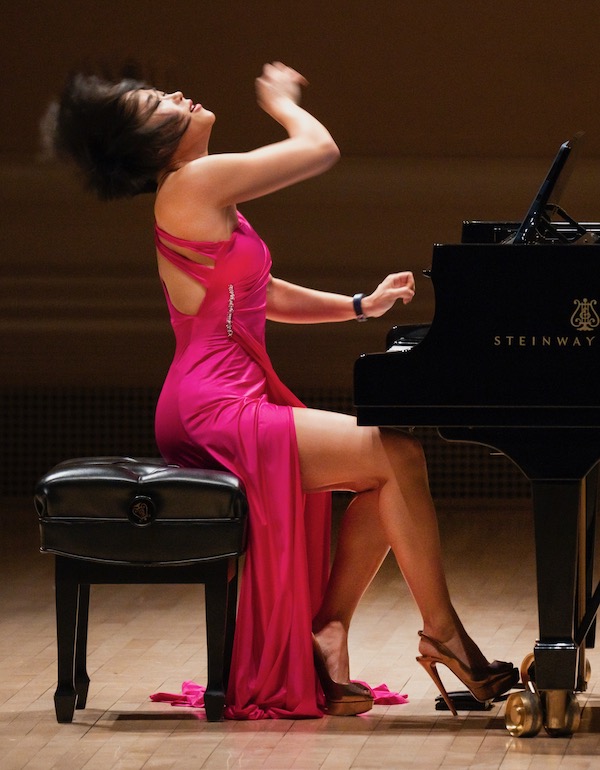Yuja Wang rocks the moderns at Carnegie Hall

It’s not every pianist who can sell out Carnegie Hall without divulging what she’s going to play, as Yuja Wang did Tuesday night. The capacity audience came prepared to gasp at her scintillating pianism, her fabulous gowns (plural), her adventurous spirit. And gasp they did—quite audibly, in the case of the fuchsia slit-up-to-here number in which she performed the program’s second half.
However, performances as disciplined and insightful (and still dazzling) as Tuesday’s have put to rest any notions of the Chinese pianist as a gold-lamé flash in the pan. The Wang “whole package”—the fashions, the wit, the sex appeal, the deep musicality—are now as much a part of 21st-century culture as Marlene Dietrich films were in the last one.
The element of surprise has become a part of the phenomenon too. Carnegie’s clever marketing line “What will she do next?” was born from a 2020 Wang recital, in which the pianist selected a piacere from a list of short pieces without indicating which one she was playing. Tuesday’s program listed items by six composers with a warning that they “may not be performed in the printed order.” The effect was to make the audience listen more acutely, at least at the beginning of each piece.
This year’s surprise? Wang played them straight through as printed.
Her admirers in Carnegie would have come to hear her play the proverbial phone book. Arnold Schoenberg, György Ligeti, and the Ukrainian jazz/classical pianist Nikolai Kapustin are not exactly the phone book, but they’re not sure winners with lovers of the piano’s Romantic core repertoire either. Wang can surely breathe Lisztian fire in the old pieces, but when she applies her vast resources of technique and tone color to the moderns, they jump off the page as well.
In his perpetual quest to deliver “the shock of the new,” Beethoven can sound as modern as anybody. Many a Romantic-style pianist has been baffled by his taut reasoning and anarchic humor, but on Tuesday Wang reveled in the shape-shifting of the Sonata in E-flat major, Op. 31, no. 3, turning its three-note opening question into a sigh, an assertion, a joke, a protest, and more as the movement unfolded.
A tendency toward nervous rushing, which has blurred her playing on past occasions, showed up again early in the Beethoven, but by the first movement’s recapitulation she had it under control, and the high-octane Scherzo and the Presto con fuoco finale were models of compelling playing right in tempo. Even the stretchy rubato phrases of the songful Menuetto felt lifted by a steady pulse.
Meanwhile, it seemed no detail of meaning went unnoticed. Even Beethoven’s trademark sforzandos had all different colors and weights, according to the musical context.
The pacing of the event felt modern too. Gone were the long treks on and off Carnegie’s large stage between numbers; Wang simply popped up for a quick bow before sitting down to the next course. As a result, the connections between Beethoven and Schoenberg became clear, as the latter’s Suite for Piano, Op. 25, vibrated with an energy and volatile imagination similar to those just heard in the sonata.
The work’s six brief movements bore Baroque titles, and Wang took note of the genre’s dance origins as she gave each one its distinctive character, from the brawny Präludium to the tinkling Musette to the fleet, staccato Gigue.
Two Ligeti etudes left vivid impressions as well. No. 6, “Automne à Varsovie” (Autumn in Warsaw) wove a descending chromatic phrase in all registers through a pianissimo whir of notes. No. 13, “L’escalier du diable” (The Devil’s Staircase), made a syncopated climb from the piano’s lowest register to its extreme tippy-top before bursting into a clangor of bells with underwater echoes, à la Debussy.
Volatility continued after intermission in Scriabin’s Sonata No. 3, Op. 23, with dramatic gestures, whispers, urgent conversations, jets of octaves, and moments of infinite tenderness—and that’s just the first movement. A surging Allegretto with a feathery trio, a ghostly Andante, and a seething Presto con fuoco finale followed, as Wang’s technical prowess made one forget all about technique and just lose oneself in Scriabin’s picturesque world.
Technical complexities multiplied in Albéniz’s “Lavapiés” from Iberia, Book III, as melodic lines and infectious dance rhythms somehow floated clear of a hand-crossing tangle of notes, and Wang repeatedly flicked elegantly-voiced chords two octaves up the keyboard.
On the other hand, the leap from Spain to Ukraine seemed short, as catchy rhythms continued to animate two preludes by Kapustin from his Op. 53. In No. 11, a bluesy tune rang out in bell-like top notes over a pianissimo murmur like the background chatter at a jazz club. No. 10 featured some Art Tatum-style filigree over an urgent left-hand riff, and hot chords to finish.
The program’s short second half left plenty of time for encores. This time, Wang bypassed her flashy YouTube hits in favor of five more intriguing items: Mendelssohn’s delicate Song Without Words in F-sharp minor, Op. 67, no. 2 (with a sly segue into the Dance of the Little Swans from Swan Lake, in an ornate, Godowsky-esque arrangement); Kapustin’s Concert Etude, Op. 40, no. 3, “Toccatina,” feather-light and metal-heavy and all over the keyboard; Danzón No. 2 by Arturo Márquez, a tender waltz with an intense, syncopated crescendo; Philip Glass’s Etude No. 6, a soft, rapid murmur growing impassioned; and the powerful last movement of Prokofiev’s Sonata No. 7, whose unusual marking “Precipitato” does not exactly mean “as fast as possible,” as it was in this performance (impressive, all the same).
Pianist Emanuel Ax performs late pieces by Chopin 8 p.m. April 28. carnegiehall.org.